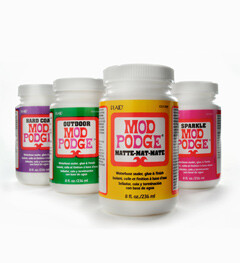Mod Podge® è un collante privo di acidi prodotto da Plaid. Viene usato soprattutto per lavori di collage e decoupage sia come fondo, sia come collante, sia come vernice di finitura e protettiva, sia per il trasferimento di immagini. Si può trovare facilmente in vendita in varie versioni, anche nel web. Il nome deriva dai termini “moderno” e “decoupage”.

E’ a base d’acqua, non tossico, si pulisce via con acqua e sapone finché non asciuga, ma una volta asciutto è resistentissimo; non fa grumi, asciuga perfettamente trasparente, irrobustisce la carta usata per rivestire e la impermeabilizza. Si può usare su pezzi dipinti ad acrilici, illustrazioni ritagliate dai giornali (come dice il barattolo, se lo applichi lasciando le pennellate visibili dona subito un’aria di “dipinto” a una qualsiasi foto), su oggettini realizzati in cartoncino o anche sui paralumi. Serve anche per fare le decalcomanie. Prendi un’illustrazione qualsiasi (basta che non sia una vera foto o stampata su carta lucida) e ce ne dai sopra parecchie mani, almeno 5, l’una perpendicolare all’altra e lasciando sempre asciugare bene tra una e l’altra. Quando tutto è ben asciutto, immergi l’illustrazione in acqua per sciogliere la carta. Il disegno dovrebbe essere rimasto catturato dal Mod Podge e presentarsi quindi come una pellicola. Per incollarla dove vuoi, usa altro Mod Podge.
In questo blog, totalmente dedicato al Mod Podge® , potete leggere la descrizione di vari tipi di prodotto, e trovare tantissimi progetti realizzati.
Alternative “dai da te” per produrre colle tipo modge podge
Prima ricetta
50% di colla vinilica bianca e 50% di acqua per finitura opaca. La famosa colla Elmers è l’equivalente della nostra Vinavil. Aggiungere un cucchiaio di vernice lucida all’acqua per ottenere una finitura lucida.
(di http://babblingsandmore.blogspot.com)
Altre ricette
(colle fatte in casa che possono essere usate in modo simile al “mod podge”; naturalmente non c’è necessariamente equivalenza, ma sono buone colle, e molto economiche)
Mescolare tre cucchiai di farina e uno di zucchero in un pentolino, aggiungere acqua fino ad ottenere una cremina liquida, mettere sul fuoco finchè il tutto non si sarà addensato, quindi togliere dal fuoco ed aggiungere un cucchiaino di aceto bianco. Far raffreddare prima dell’utilizzo. Conservare in un contenitore ermetico, possibilmente in frigo (dura circa due settimane). E’ un modge podge indicato per cartapesta, collage e simili, ci mette solo un po’ più di tempo ad asciugare rispetto alle colle per carta in commercio.
(di http://www.minieco.co.uk)
_________________
Per questa ricetta di modge podge servono: latte, aceto bianco, bicarbonato di sodio, acqua, un pentolino e un colino.
Versare 1 tazza e mezzo di latte nel pentolino, mettere sul fuoco e una volta caldo aggiungere 3 cucchiaini di aceto bianco. Lasciare sul fuoco mescolando, finchè il siero non si sarà separato dal caglio.
Filtrare col colino e impastare la parte solida per amalgamare e formare una palla, poi rimettere nel pentolino, aggiungere un po’ d’acqua ed un cucchiaio di bicarbonato di sodio, mettere sul fuoco e portare ad ebollizione. Mescolare energicamente.
Una volta raffreddato, il composto può essere usato come colla. Se la consistenza risulta essere troppo densa, correggere aggiungendo acqua o altro bicarbonato di sodio, finchè non si presenta come una crema densa.
La proteina del latte (caseina) è un collante naturale. L’aceto serve a separare il siero dalla proteina, mentre il bicarbonato neutralizza l’acidità dell’aceto.
(di http://www.science-sparks.com)
_____________________________
Per questa ricetta di modge podge servono acqua, sciroppo di mais (lo trovi nei negozi di biologico o ad esempio qui), amido di mais (maizena), aceto bianco.
Mescolare in un pentolino una tazza scarsa di acqua, un cucchiaino di aceto e due cucchiai di sciroppo di mais, portare a ebollizione, quindi togliere dal fuoco.
Preparare a parte una crema liscia e senza grumi mescolando una tazza scarsa d’acqua fredda con due cucchiai di amido di mais, rimettere il pentolino sul fuoco ed aggiungere al primo composto la crema, mescolando continuamente. Una volta in ebollizione, continuare a cuocere per almeno un altro minuto. Raffreddandosi la nostra colla si addenserà molto, mentre appena tolta dal fuoco sembrerà piuttosto liquida.
(di http://www.icanteachmychild.com)

DIY glue and “modge podge” – Mod Podge® It is an adhesive acid free produced by Plaid. It is used mainly for works of collage and decoupage both as a primer, both as glue, both as finishing and protective paint, and both for the transfer of images. You can find it on sale in different versions, for example here:






The name is derived from the terms “modern” and “decoupage”.
It is water-based, non-toxic, can be cleaned off with soap and water until it dries, but when dry is extremely resistant.
Available in a variety of finishes, Mod Podge is a milky white liquid transparent that dries in less than 10 minutes.
There are various types of use:
– Antique Matte Finish: give any surface an heirloom look with this special Mod Podge formulation.
– Gloss Finish: this is the original Mod Podge formulation with a lustrous, glossy sheen.
– Matte Finish: choose this Mod Podge formulation when you are looking for a low-luster, satin finish.
– Outdoor: decoupage projects for the outdoors. Seal and protect wood, terra cotta, slate, tin, and more.
– Sparkle Finish: the same all-purpose performance of Mod Podge with the added bonus of sparkle; it adds a glistening finish to any project.
– Super Gloss Finish: this Mod Podge adds a super shiny, glass-like finish to your project. No special tools are needed for a smooth, brushstroke-free application.
– Wash Out for Kids: ideal for children’s crafts, Mod Podge Wash Out for Kids easily washes off surfaces and out of machine-washable clothing. It has a glossy finish.
In this blog, totally dedicated to Mod Podge®, you can read the description of the various types of product, and find lots of projects.
DIY glue and “modge podge”
DIY alternatives to produce glues modge podge type
Prima ricetta
50% white glue (like Elmers)
50% water
1 TBS clear varnish (for Glossy finishg)
(by http://babblingsandmore.blogspot.com)
DIY glue and “modge podge”
Other recipes
(homemade glues that can be used in a similar way to the “mod podge”; of course there is not necessarily equivalent, but they are good glues, and very cheap)
Mix three tablespoons of flour and a tablespoon of sugar in a saucepan, add water to make a liquid cream, put on the fire until everything has thickened, then remove from heat and add a teaspoon of white vinegar. Let cool before using.
Store in an airtight container, preferably in the fridge (lasts about two weeks). It is a modge podge suitable for papier mache, collage and the like, it takes just a little more time to dry than glue for paper on the market.
_________________
For this recipe serve: milk, white vinegar, baking soda, water, a saucepan and a colander.
Pour 1 cup and a half of milk in the pan, put on fire, and when hot, add 3 teaspoons of white vinegar. Leave on the heat, stirring, until the serum will not be separated from the curd.
Filter with colander and mix the solid part to mix and form a ball, then put back into the saucepan, add a little water and a tablespoon of baking soda, put on fire and bring to a boil. Mix thoroughly.
Once cooled, the compound can be used as glue. If the consistency is too dense, correct by adding water or other baking soda, until it presents itself as a thick cream.
Milk protein (casein) is a natural glue. The vinegar is used to separate the whey from the protein, while the bicarbonate neutralizes the acidity of the vinegar.
(di http://www.science-sparks.com)
_____________________________
For this recipe serve water, corn syrup, corn starch, white vinegar.
Mix in a saucepan a scant cup of water, a teaspoon of vinegar and two tablespoons of corn syrup, bring to a boil, then remove from heat.
Prepare separately a cream smooth and lump-free mixing a scant cup of cold water with two tablespoons of corn starch, put the pan on the heat and add the cream to the first mixture, stirring constantly. Once boiling, continue to cook for another minute. Cooling our glue will thicken much, and just removed from the heat it seems fairly liquid.

